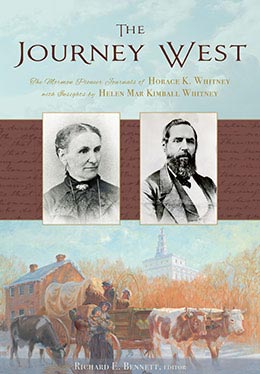Editor's Notes
Editing and annotating the six 1846–47 pioneer journals of Horace K. Whitney, which cover 631 pages and contain some two hundred thousand handwritten words, has been a daunting challenge. The leather-bound journals themselves are remarkably well preserved some 170 years later. And, fortunately for modern readers, Whitney was a well-educated person, a preferred scribe in the camps, with a good command of the English language; however, he often wrote on the fly, in a hurry, and usually at night, with only the flicker of a lonely candle to light his way. Thus his prairie trail penmanship is not always easy to read. Fortunately, his entries were recorded almost always in ink, with very little fading of the original. Nevertheless, at least three pairs of eyes have carefully compared his original to the typescript and our final digitized version, often with the aid of a magnifying glass for the very hardest entries.
The addition of the reminiscent writings of his wife, Helen Mar Kimball Whitney, will greatly contribute to the value of his journals. Whereas every word of his journals has been copied, transcribed, and carefully edited, Helen Mar’s reminiscences are selectively chosen based upon their relevancy to her husband’s accounts. Though published previously, have never before been coupled with her husband’s journals. Together, they take on a unique male/
To further enrich this work, I have added a substantial number of footnotes that explain events, places, significant experiences, and Mormon doctrines and practices that should assist the reader. Very few names are included in the footnotes (with the exception of non–Latter-day Saints met on the trail); however, virtually every other name mentioned in the Whitney journals is briefly described with dates of birth and death and lifetime highlights. These are located in the glossary of names found near the end of the book. It represents one of the more complete listings of Latter-day Saints who were moving west in 1846–47 and that alone may be worth the “cost of admission.”
As to the actual editing process, the following guidelines and procedures have been followed:
- The precise spelling, grammar, and capitalization of the original journals and reminiscences have been preserved, including incorrect place-names and other errors of fact; however, in cases of an obvious or egregious error, I have occasionally included the intrusive term sic, meaning “as found in the original work.” Editorial insertions, when deemed necessary for clarification within the texts, have been made within [square brackets] as opposed to (parenthesis) originally inserted by the Whitneys themselves.
- The many explanatory footnotes that I have added to the text and inserted at the bottom of the page are provided to add color, commentary, elucidation, and valuable related information; they are usually placed at the end of sentences and daily entries.
- The use of **** in Helen Mar’s reminiscences reflects her redactions and original omissions of text.
- Time references in the journals are “a.m.” and “P. M.” in the original text and have been retained accordingly.
- Columns of names, ledger and accounting entries, mileages, etc., have been preserved as closely as possible to the originals, although with some slight variations.
- In almost all cases, periods, commas, apostrophes, dashes, and underlines are retained, regardless of their grammatical correctness; however, occasionally punctuation has been added or altered for clarification—[,] or [.].
- Occasionally, first names have been added in [square brackets] within the text where confusion may exist because of duplication of names or other incongruities.
- The dashes found in the original journals have been preserved, though they are somewhat out of style today.
- Occasionally, years have been added to the original entry for clarification purposes.
- The pagination found herein is continuous throughout all six of the Whitney journals, whereas, in the originals, each journal has its own separate pagination, if at all.
In sum, every effort has been made to ensure accuracy, clarity, and completeness so that the reader can rest assured that what is offered here is a faithful representation of what
Horace Whitney and Helen Mar recorded by hand in his jo
